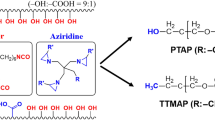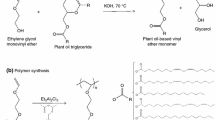Abstract
Polymers and oligomers having carbamate functional groups have been used in a variety of curable coating compositions. Carbamate functional polymers offer many advantages for automotive topcoats, such as outstanding resistance to environmental etching, scratching and marring, humidity, and UV exposure. Hydrophobic carbamate oligomers suitable for crosslinking with standard amino resins were synthesized and formulated into stable one-pack automotive clearcoats with low volatile organic compound (VOC) and excellent physical properties. Because of their unusually steep thermal viscosity curves, these oligomers are particularly adaptable to hot spray techniques that enable coatings in the 85–90% weight solids range to be applied with conventional electrostatic mini-bells.
Similar content being viewed by others
References
Private Communication, Martin, G.E. and Wolff, G.T., “Environmental Etching of Automotive Coatings, Joint Research Study,” BASF internal research report, Poly 264–92 (1990).
Wolff, G.T. and Rogers, W.R. et. al, “Spotting of Automotive Finishes from the Interactions Between Dry Deposition of Crustal Material and Wet Deposition of Sulfate,”J. Air Waste Manage. Assoc., 40, 1638 (1990).
Armstrong, V.C., Farlow, D.W., and Moodie, R.B., “The Hydrolysis of Amides, Esters, and Related Compounds in Acid Solution. Part I. Amides, Carbamates, and Ureas,”J. Chem. Soc. B, 275 (1968).
Armstrong, V.C. and Moodie, R.B., “The Hydrolysis of Amides, Esters, and Related Compounds in Acid Solution. Part II. Carbamates,”J. Chem. Soc. B, 937 (1969).
Payne, K.L., Jones, F.N., and Brandenburger, L.W., “Hydrolytic Stability of Oligoesters in Simulated Water-Reducible Coating Formulations,”Journal of Coatings Technology, 57, No. 723, 35 (1985).
Peijnenburg, W.J.G.M., “The Use of Quantitative Structure-Activity Relationships for Predicting Rates of Environmental Hydrolysis Processes,” National Institute of Public Health and Environmental Protection, Laboratory of Ecotoxicology, Bilthoven, The Netherlands, IUPAC, 1991.
Pourdeyhimi, B., Wang, X., and Lee, F., “Evaluation of Scratch and Mar Resistance in Automotive Coatings,”Eur. Coat. J., 3, 75, 1999.
Gregorovich, B.V. and Hazan, L., “Environmental Etch Performance, Scratch and Mar of Automotive Clearcoats,”Prog. Org. Coat., 24, 131, 1994.
Chen, M.J., “Moisture-Curable Silylated Acrylic Clear Coats—Improvements in Mar Resistance,” Presented to Detroit Society for Coatings Technology, OSI Specialties Inc., December 1995.
Ryntz, R.A., Abell, B.D., Pollano, G.M., Nguyen, L.H., and Shen, W.C., “Scratch Resistance Behavior of Model Coating Systems,”Journal Coatings Technology, 72, No. 904, 47 (2000).
Hill, L.W., “Mechanical Property/Property Relationships in Coatings,”ACS, PMSE Preprints, American Chemical Society, Washington, D.C., 79, 405, 1998.
Gregorovich, B.V. and McGonigal, P.J., “Mechanical Properties of Coatings Needed for Good Scratch and Mar,” inProc. Advanced Coatings Technology Conference ASM/EDS, 1992.
Courter, J.L., “Mar Resistance of Automotive Clearcoats: 1. Relationship to Coating Mechanical Properties,”Journal of Coatings Technology,69, No. 866, 57 (1997).
Gregorovich, B.V. and Hazan, L., “Environmental Etch Performance and Scratch and Mar of Automotive Clearcoats,”Proc. XIXth International Conference in Organic Coatings Science and Technology, 19, 205–218, Athens, Greece, 1993.
Rehfuss, J.W. and St. Aubin, D.L., “Composite Color-Plus-Clearcoating Utilizing Carbamate-Functional Polymer Composition in the Clearcoat,” U.S. Patent 5,356,669, October 18, 1994.
Green, M.L., “Low VOC Curable Coating Compositions Utilizing Carbamate-Functional Compound,” U.S. Patent 5,693,724, December 2, 1997.
Koleske, J.V., “Physical and Mechanical Properties: Hardness,”Paint and Coatings Testing Manual, Gardner-Sward Handbook, ASTM: MNL 17, Philadelphia, PA, 1995.
Author information
Authors and Affiliations
Additional information
Automotive Coatings Technical Center, Southfield, MI 48034.
Rights and permissions
About this article
Cite this article
Green, M.L. Low VOC carbamate functional coatings compositions for automotive topcoats. Journal of Coatings Technology 73, 55–62 (2001). https://doi.org/10.1007/BF02698024
Issue Date:
DOI: https://doi.org/10.1007/BF02698024




